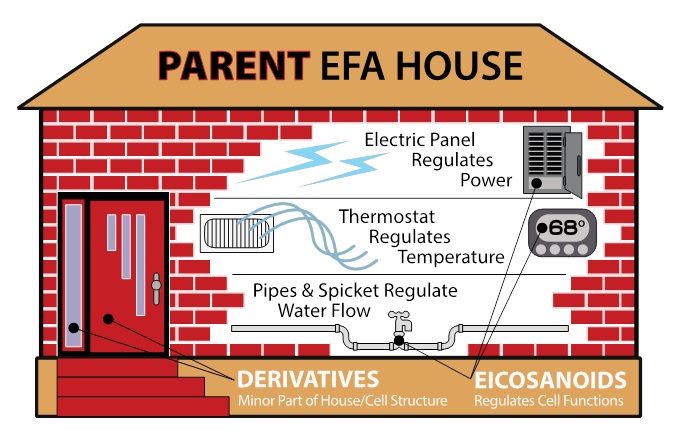
Essential EFAs :
A New Era in Combatting Chronic and
Acute Inflammation and Much More…
by Professor Brian Peskin
Instead of treating diseases/disorders by blocking/impeding and “managing” the illness’ progression, the correct focus should be to reverse and optimize the resolution of any underlying disease/disorder. Once inflammation is reduced, healing accelerates, naturally. Systemic inflammation is a part of many intractable diseases, including cancer, heart/vascular disorders, diabetes, arthritis, COPD … to name a few. Once inflammation is reduced, healing accelerates, naturally. Without addressing this key area, other attempts will be futile and ineffective.
INTRODUCTION:
Unfortunately, many physicians and healthcare professionals have not been exposed to EFA (Essential Fatty Acid)-based science. Although extremely important, the field is mischaracterized by many as simply an exploration of fish oil. It is so much more than that. Yes, the same ESSENTIAL plant-based oils so many so-called “health experts” are parroting about with no distinction between:
a) organic/fulling functional or b) processed/adulterated/harmful.
An additional and often overlooked significant cause of D6D impairment is because patients consume adulterated cooking oils; often over decades — laying the foundation for this metabolic impairment.
I find an illustration may be helpful. Picture a house in Houston, Texas, in late February 2021. The ambient temperature dropped dramatically even though the exterior structure was sound. Many people had to abandon their homes because utilities (electricity, heat, and water) were not properly functioning.
This house/utilities analogy is applicable to what is required so a patient’s EFA metabolism is fully functional (See Illustration Below).
There are 3 main classes of EFA-related function:
1) Parents: The “brick and mortar” of each cell membrane (Parent omega-6 / -3; LA (linoleic acid) & ALA (alpha-linolenic acid)) — high quantities, 100 trillion cell membranes with 25% - 33% of “Parents” incorporated into each cell’s lipid bilayer.
2) Derivatives: Made from both “Parents” in small quantities (e.g., GLA, DGLA, AA, (fish oil’s EPA & DHA), etc.).
3) Eicosanoids (such as PGE1): The complex signaling molecules. Made from the Derivatives in even smaller quantities. They may not even enter the bloodstream and can be extremely short-acting.
A home with broken / crumbling walls and great heat and water is insufficient for living, just as a home with great structure (lots of Parent EFAs only) and no electricity, heat, or water in winter is insufficient for living. A precise combination of both quantities and ratios of all 3 classes of EFA-related components is required for maximizing patient outcomes.

TYPE I and TYPE II DIABETIC PATIENTS
Diabetic patients often suffer from numerous issues such as retinopathy, neuropathy, nephropathy, and foot ulcers. It is well documented that diabetic patients have impaired
Δ-6
desaturase (D6D) metabolic pathways from impaired insulin production. In particular, this metabolic defect causes a poor anti-inflammatory response in Type I patients. Even with insulin therapy, the D6D pathway remains deficient:
Type II patients also suffer significant impairment of D6D activity: “The effect of prostaglandin E1 on the increased binding of the insulin was found to be reversible…. Binding capacity increased 2-fold.”
Insulin sensitivity increases with PGE1 output.9 Because of the reversibility of insulin binding, the impaired pathway must be compensated for daily.
Frustrating for physicians is that diabetic patients frequently consume an overabundance of processed foods containing adulterated oils.3 They are at great risk for chronic low-grade cellular inflammation — triggering long-term cellular stress. The team, led by Professor Ernst, described how the cell’s UPR [unfolded protein response] senses nonfunctional/ adulterated membrane lipids and responds accordingly, triggering chronic inflammation: “…The study provides a new perspective on the active role of biological membranes may be a game changer for the understanding of a great variety diseases.” This is highly underpublicized, yet critical information.
DERMATOLOGY
There is an increasing epidemic of dermatologic diseases. An understanding of EFA metabolism can help physicians combat this rise in cases: “Atopic dermatitis (AD) has been related to a deficiency of
Δ-6 (D6D)
desaturase….” Furthermore, there is identification of a fatty acid Δ-6 (D6D)
desaturase deficiency in human skin fibroblasts: [Fibroblasts are in the dermis underneath the outer layer of skin. Fibroblasts also allow skin to generate connective tissue to recover from injury.]
ALZHEIMER’S
With a defective cellular lipid membrane, membrane-based proteins may leak out. This is likely why the beta-amyloid hypothesis as the cause of Alzheimer’s has failed and pharmaceutical success in the area remains largely ineffective. Alzheimer’s is now known as a cardiovascular disease caused by cellular impairment in the (at least 40 million) capillaries in the brain (EFA structure is comprised of exclusively Parent omega-6). The following extraordinary journal article published in 1990 “hits the nail on the head”: “The findings strongly indicate abnormalities in Δ-6 (D6D)
desaturase desaturation. …[T]he findings strongly indicate abnormalities of D6D desaturase in Alzheimer's disease. The decrease in 22:6 (n -3) further supports altered Δ-6 (D6D)
desaturaseactivities. Abnormalities in the destruction/elongation process [initiating with Δ-6 (D6D)
desaturase ] of PUFA (polyunsaturated fatty acid) and resultant membrane dysfunction may play a key role in the pathogenesis of Alzheimer's disease.”
“Evidence is fast accumulating which indicates that Alzheimer’s disease is a vascular disorder with neurodegenerative consequences rather than a neurodegenerative disorder with vascular consequences.”
Furthermore, as the 2011 Nature Reviews: Neuroscience article makes clear: “Patients with Alzheimer’s disease or other dementia-causing diseases frequently show focal changes in brain microcirculation….
consistent with the chronic cerebral hypo-perfusion and hypoxia that were observed in these individuals.”
“In a series of 300 autopsy cases of AD, Kalaria and Ballard reported 98% CAA [cerebral amyloid angiopathy], 100% microvascular degeneration....”
CARDIOVASCULAR DISEASE
The EFA content of the lining of arteries (intima) and structure of the capillaries is comprised entirely of Parent omega-6 (LA). If this omega-6 is adulterated/nonfunctional from patients consuming processed foods/processed cooking oils, then the arteries/capillaries/veins will suffer chronic inflammation, resulting in initiation of plaque, occlusions, and disfunction. Spiteller’s groundbreaking insights makes clear it is the exogenous, consumed and already adulterated LA from processed foods — not in vivo (by the body) oxidation — that are the cause of the CVD-related and other systemic damage from “oxidized cholesterol.”
Intimal hypoxia (lack of oxygen) is also an initiating cause of CVD and fully functional Parent omega-6 significantly improves cellular oxygenation. Dr. Campbell’s seminal article, “Abnormal fatty acid composition and impaired oxygen supply in cystic fibrosis patients,” demonstrates that the Parent omega-6’s oxygen in the cell membrane can (reversibly) disassociate (release) oxygen — at physiologic pressure — increasing the tissue cellular oxygenation.
In addition to the bloodstream, oxygen can come from the cell membrane itself. Chronic low-grade inflammation plays a role in cardiac hypertrophy and heart failure. Both microcirculation and macrocirculation of the heart are improved with the strong anti-platelet aggregation effect of PGE1. Increased cellular oxygenation/decreased hypoxia also occurs with increased PGE1. Increased blood flow and cardiovascular support also occur.
“Microcirculation and macrocirculation of the heart are improved with the strong anti-platelet aggregation effect of PGE1.”32 “Prostaglandins are capable of limiting thrombosis.”
CANCER
Chronic inflammation, which contributes to heart disease, may be a key to unlocking the mysteries of cancer. Scientific America’s feature article delivered a shocker in the July 2007 issue, pages 60-61. The article states that cancer researchers have “changed focus.” Cancer researcher Robert Weinberg of MIT states:
“The connection between inflammation and cancer has moved to center stage in the research arena. … [I]nflammation is the fuel that feeds it [the malignant cancer]… In this rewriting of the textbook…
“…It has been indicated that experiments in the utilization of EFA in cancer modulation exist regarding intake and effect on cell structure and biochemical interactions within the cell in the prevention of cancer development.”
“A lower level of D6D was seen in breast tumors compared to normal tissues.”
“Chronic inflammation is a major causative factor in human malignances. Pro-inflammatory cytokines influence tumor microenvironment and promote cell growth and survival and angiogenesis such that tumor cell growth is facilitated.”
COPD
COPD is also associated with systemic inflammation. Furthermore, there is a markedly increased risk of cardiovascular disease (particularly coronary artery disease) and lung cancer in patients with COPD. Also, there is strong associative evidence that the inflammatory cells / mediators in COPD are also relevant to the development of cardiovascular disease and lung cancer.
“[Current] pharmaceutical therapy for the treatment of inflammatory process in COPD is relatively ineffective. Corticosteroids remain the cornerstone of asthma treatment but are generally relatively ineffective in COPD."
*Brian Peskin is a world-renowned theoretical research scientist specializing in lipids-based pharmacognosy. Peskin’s focus is the modulation of physiologically targeted essential fatty acids (EFAs) and their eicosanoid metabolites. Once inflammation is reduced, healing accelerates, naturally.
FOOTNOTES:
- Anton SD et al. Differential effects of adulterated versus unadulterated forms of linoleic acid on cardiovascular health. J Integr Med. 2013;11(1): 2–10.
- Alberts B et al. Molecular Biology of the Cell. 3rd edition. New York: Garland Science; 1994; Murray B et al. Harper’s Illustrated Biochemistry. 26th edition. New York: McGraw-Hill; 2003; Guyton AC, Hall JE. Textbook of Medical Physiology. 9th ed. Philadelphia: W.B. Saunders Company;1996.
- Brenner RR. Hormonal modulation of Δ-6 and Δ-5 desaturases: case of diabetes. Prostaglandins, Leukotrienes, and Essential Fatty Acids. 2003;68:151-162.
- Das UN. Essential fatty acids: biochemistry, physiology and pathology. Biotechn. 2006;1:420-439.
- Mikhailidis DP et al. The effect of dihomogammalinolenic on platelet aggregation and prostaglandin release, erythrocyte membrane fatty acids and serum lipids: evidence for defects in PGE1 synthesis and Δ5-desaturase activity in insulin-dependent diabetics. Diabetes Research. 1986;3:7-12.
- Brown JE, Lindsay RM, Riemersma RA. Linoleic acid metabolism in the spontaneously diabetic rat: Δ-6 desaturase activity vs. product / precursor ratios. Lipids. 2000;35(12):1319-23.
- Huang M et al. FADS Gene Polymorphisms, Fatty Acid Desaturase Activities, and HDL-C in Type 2 Diabetes. Int. J. Environ. Res. Public Health. 2017;14(6):572.
- Ray TK et al. Regulation of insulin receptor activity of human erythrocyte membrane by prostaglandin E1 [PGE1]. Biochim Biophys Acta. 1986;856(3):421-7.
- Halbleib K et al. Activation of the Unfolded Protein Response by Lipid Bilayer Stress. Molecular Cell. 2017;67( 4):673-684.e8; Saarland University. Molecular biologists discover an active role of membrane lipids in health and disease. Available at: www.sciencedaily.com/releases/2017/08/170804091341.htm. (Accessed February 28, 2022).
- Simon D et al. Gamma-Linolenic Acid Levels Correlate with Clinical Efficacy of Evening Primrose Oil in Patients
with Atopic Dermatitis. Adv Ther. 2014;31:180–188.
- Willard DE et al. Identification of a fatty acid -6 desaturase deficiency in human skin fibroblasts. The Journal of Lipid Research, 2001;42:501-508.
- Nakada T et al. Membrane fatty acid composition shows a Δ-6 desaturase abnormality in Alzheimer's disease, NeuroReport. 1990;1:153-155.
- de la Torre JC, Stefano GB. Evidence that Alzheimer’s disease is a microvascular disorder: the role of con¬stitutive nitric oxide. Brain Research Reviews. 2000;34(3):119-136.
- Zlokovic B. Neurovas¬cular pathways to neurodegeneration in Alzheimer’s disease and other disorders. Nature Reviews: Neuroscience. 2011; 12:723-738.
- Attems J, Jellinger KA. The overlap between vascular disease and Alzheimer’s disease – lessons from pathology (Vascular risk factors and Alzheimer’s disease). BMC Medicine. 2014;12(206):1-12.
- Chapkin RS et al. Metabolism of essential fatty acids by human epidermal enzyme preparations: evidence of chain elongation. J Lipid Res. 1986; 27:945-954.
- Andersson A, et al. Fatty acid profile of skeletal muscle phospholipids in trained and untrained young men. Am J Physiol Endocrinol Metab. 2000;279:E744-E751.
- Staprãns I et al. Oxidized cholesterol in the diet is a source of oxidized lipoproteins in human serum. J. Lipid Res. 2003;44: 705–715; “Consumption of oxidized PUFA-cholesterol esters [LA] seems to be responsible for the initial damage to endothelial cells [inner arterial lining, i.e., intima].” Ref.: Spiteller G. Peroxyl radicals: Inductors of neurodegenerative and other inflammatory diseases. Their origin and how they transform cholesterol, phospholipids, plasmalogens, polyunsaturated fatty acids, sugars, and proteins into deleterious products. Free Radical Biol Med. 2006;41:362.
- Campbell IM et al. Abnormal fatty acid composition and impaired oxygen supply in cystic fibrosis patients. Pediatrics. 1976;57:480–486.
Libby P. Inflammation in atherosclerosis. Nature. 2002;420(6917):868–874.
- Ren, H-X et al. Effect of prostaglandin E1 in patients with advanced lung cancer treated with chemotherapy.” Int J Clin Exp Med. 2018;11(3):2285-2291.
- Guo S, DiPietro LA. Factors affecting wound healing. J Dent Res. 2010;89(3):219–229.
DasUN. A defect in the activity of Δ6 and D5 desaturases may be a factor
in the initiation and progression of atherosclerosis. Prostaglandins Leukot Essent Fatty Acids. 2007;76(5):251–268; Also, “[O]mega-6 PUFAs also have powerful anti-inflammatory properties that counteract any proinflammatory activity,’ say the advisory authors. ‘It’s incorrect to view the omega-6 fatty acids as “pro-inflammatory.”’ Ref.: Farvid MS et al. Dietary linoleic acid [LA/ parent omega-6] and risk of coronary heart disease: a systematic review and meta-analysis of prospective cohort studies. Circulation. 2014;130:1568–1578; Terano T et al. Effect of oral administration of highly purified eicosapentaenoic acid on platelet function, blood viscosity and red cell in healthy human subjects. Atherosclerosis. 1983;46:321–331.
- Witt & Müller, 1987: In: Sinzinger HF, Schrör K, eds. Prostaglandins in the Cardiovascular System,
- Birkhäuser Verlag, Basel, Switzerland, 1992; Witt & Baldus,1988: ibid.
Article references: Balkwill F et al. Smoldering and Polarized Inflammation in the Initiation and Promotion of Malignant Disease. Cancer Cell. 2005; 7(3):211-217; Lewis C, Pollard J. Distinct Role of Macrophages in Different Tumor Microenvironments. Cancer Research. 2006;66(2):605-612; Visser K et al. Paradoxical Roles of the Immune System during Cancer Development. Nature Reviews Cancer, 2006;6(1):24-37.
- Willard DE et al. Identification of a fatty acid -6 desaturase deficiency in human skin fibroblasts. The Journal of Lipid Research. 2001;42:501-508.
- Conklin, KA. Dietary polyunsaturated fatty acids: Impact on cancer chemotherapy and radiation. Alternative Medicine Review. 2002;7(1):4-21.
- Das UN. Can essential fatty acids reduce the burden of disease(s). Lipids Health Dis. 2008;7:9.
- King PT. Inflammation in chronic obstructive pulmonary disease and its role in cardiovascular disease and lung cancer. Clin Trans Med. 2015;4:26.
Subscribe to Beyond 50's Radio Updates!
Beyond 50 values your personal information. Your email will
not be used, sold, or
shared with any outside party.

Do You Have an Amazon Echo Dot?
Just say, "Alexa, play the podcast, Beyond 50 Radio Show " to hear
the interviews.
VISIT
BEYOND 50's BLOG

RECENT EPISODES:
Follow the Pipelines: The Great Game for Oil in the Middle East
Brilliant Disguise
You're the F*cking Problem! A Guide to Getting Out of Your Own Way
America's Financial Reckoning Day: The Presidential Election
Four Lessons from My Three Sons: How You Can Raise Resilient Kids
Why the Blackmail Racket?
The Quantum & The Dream: Visionary Consciousness, A.I. , and the New Renaissance
Spirit Traveler:
Unlocking More Mysteries of Ancient Sites
Around the World
Know Your Dog's True Nature: Understanding Canine Personality Through the Five Elements
The Manchurian Journalist
BEYOND 50's
BEST RESOURCES:



